- Home
- > Nature online
- > Life
- > Dinosaurs and other extinct creatures
- > Non-dinosaur reptiles
- > Mammal-like reptiles
Primary navigation
- Life
- Mammals
- Birds
- Reptiles, amphibians and fishes
- Insects and spiders
- Other invertebrates
- Dinosaurs and other extinct creatures
- Dino directory
- The most complete Stegosaurus in the world
- Prehistoric world in pictures
- News
- Archaeopteryx - snapshot of evolution in action
- Mass extinctions
- Non-dinosaur reptiles
- Ida - the clue to primate evolution?
- Baryonyx (video)
- Augmented reality Coelophysis
- Scelidosaurus (video)
- World's smallest mini mammoth (video)
- Dino-birds
- Big teeth for a tiny dinosaur
- T.rex: the killer question quiz
- Virtual specimens
- Ostrich dinosaurs
- The search for DNA in amber
- Plants and fungi
- Human evolution
Mammal-like reptiles
Mammal-like reptiles were the prehistoric reptilian ancestors of mammals, and were the dominant land animals around 260 million years ago. The term broadly covers the non-mammalian synapsids, some of which can be explored below.
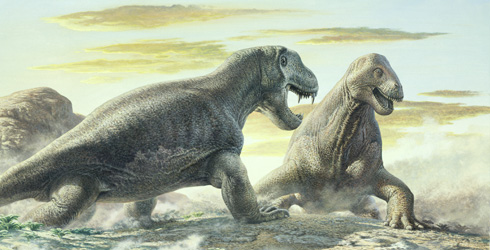
Name: Anteosaurus
Age(s): 266 - 260 million years ago
Period: Late Permian (Capitanian)
Size: 5-6 metres
Notes: Anteosaurus was a large carnivore and probably weighed around 500-600kg. It belongs to the group Anteosauria and is known from numerous skulls and other remains.
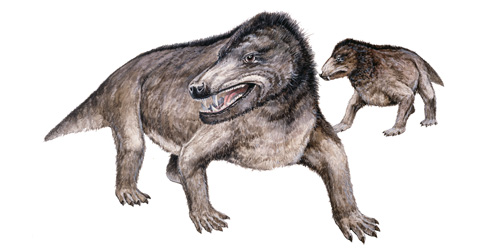
Name: Cynognathus
Age(s): 242-240 million yers ago
Period: Early-Mid Triassic (Spathian-Anisian)
Size: 1m
Location found: South Africa (Karoo region), Lesotho, Argentina, Antarctica, China
Notes: The skull of Cynognathus possessed a secondary palate, allowing it to breathe and eat at the same time. It lacked ribs in the posterior trunk region, suggesting that it had an efficient diaphragm. Pits in the snout region of the skull suggest the presence of vibrissae (whiskers). Its name means 'dog jaw'.
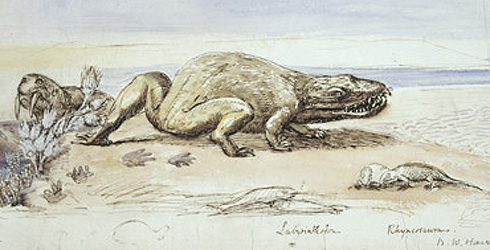
Dicynodon is the animal on the left of the image above.
Name: Dicynodon
Age(s): 260-250 million years ago
Period: Late Permian
Size: 1.2 metres
Location(s) found: South Africa, Tanzania, Russia, China
Notes: Dicynodon was a herbivore and probably fed on roots and tubers. Its mouth had two tusks and scientists think it possessed a keratinous beak. Its name means 'two dog teeth'.
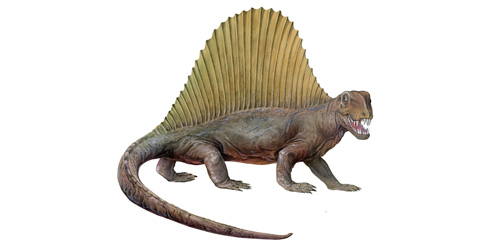
Name: Dimetrodon
Age(s): 299-260 million years ago
Period: Early-Mid Permian
Size: 3 metres
Notes: Dimetrodon was a large carnivore, weighing around 150Kg. It is famous for the large sail on its back, which was supported by long spines from the backbone. The sail was probably used to regulate its body temperature, turning to face the sun to warm up and away from it to cool down. Dimetrodon was a synapsid, belonging to the family Sphenacodontidae.

Name: Lystrosaurus
Age: 250 million years ago
Period: Late Permian-Early Triassic
Size: 1 metre
Location(s) found: Antarctica, South Africa, India, Russia, China, Mongolia
Notes: Lystrosaurus was a barrel-chested herbivore and probably lived in an arid environment. It had a pair of tusks, robust legs and a stumpy tail. It is known from several specimens, including well-preserved skulls. The genus, or group, survived the extincition at the end of the Permian.
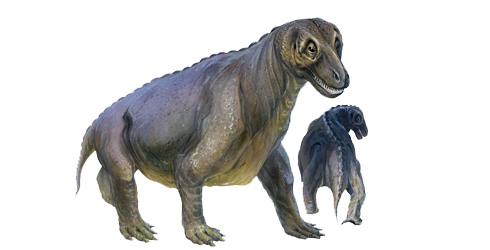
Name: Moschops
Age: 285 million years ago
Period: Early Permian
Size: 5 metres
Location(s) found: South Africa (Karoo region)
Notes: Moschops was a heavily-built mammal-like reptile. It was a herbivore with a large head and a short tail. Its skull was thickened and it is thought males participated in head-butting. Moschops belongs to the family Tapinocephalidae. The name Moschops means 'calf face'.
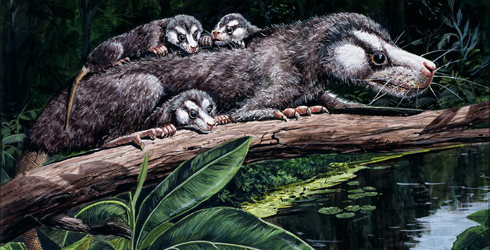
Name: Oligokyphus
Age(s): 227-180 million years ago
Period: Late Triassic-Early Jurassic
Size: 0.5 metres
Location(s) found: UK, Germany, China
Notes: Oligokyphus was a 'weasel-like' animal and had double-rooted cheek teeth. The forelimbs were held directly underneath the body. The species Oligokyphus major and Oligokyphus minor were considered by one study to represent the male and female of the the same species.

Name: Thrinaxodon
Age: 251 million years ago
Period: Early Triassic (Induan)
Size: 0.5 metres
Location(s) found: South Africa (Free State Province), Antarctica
Notes: Thrinaxodon was a fox-sized cynodont. Pits in its skull show there were blood vessels and nerves for vibrissae (whiskers). This suggests that the animal had fur and was probably endothermic (absorbs energy in the form of heat). Thrinaxodon also had seven neck vertebrae, the same as modern mammals. It lived in burrows, or at least used them, as a specimen was found preserved in a burrow that had apparently filled during a flash flood. Its name means 'trident tooth'.
Toolbox
- Contact and enquiries
- Accessibility
- Site map
- Website terms of use
- © The Trustees of the Natural History Museum, London
- Information about cookies
- Mobile